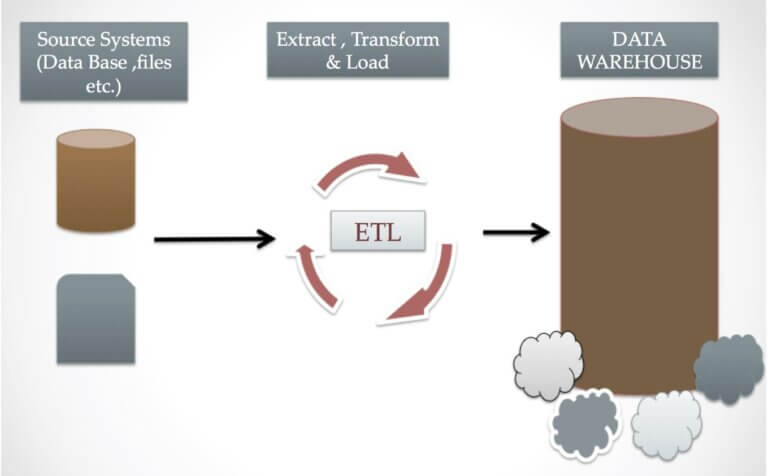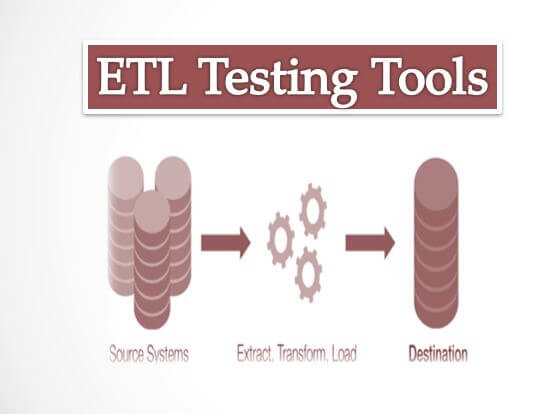ETL Testing
Types of ETL Testing
ETL tools
ETL Testing tools
Why ETL Testing ?
ETL Testing Process
Responsibilities of an ETL Tester
ETL Testing Challenges
Data Ware Housing
Data Modelling
Data Mining
OLTP Vs OLAP
Test Scenarios for ETL Testing
ETL Testing Bugs
SQL Queries Used in ETL Testing
DataBase Testing Vs ETL Testing
ETL Testing: Definition , Importance , Types and Tools
ETL Testing refers to the process of validating, verifying, and qualifying data while preventing duplicate records and data loss. This article will present you with a complete idea about ETL testing definition, ETL tools , importance etc.
ETL testing is verifying the data safely traveled from its source to its destination and It should be high quality data before it enters your Business Intelligence reports.
ETL refers to a process used in data integration to extract data from various sources, transform it into a format suitable for analysis, and load it into a target system.
The ETL process is commonly used in data warehousing, where data is collected from various sources and transformed into a format that can be easily analyzed.
We will learn below topics in this article.
What is ETL?
- ETL stands for extract, transform, and load.
- When referring to extract, load and transform we are referring to data.
- ETL is a process that extracts the data from different source systems, then transforms the data and finally loads the data into the Data Warehouse system. Full form of ETL is Extract, Transform and Load.
- Extracts data from homogeneous or heterogeneous data sources.
- Transforms the data for storing it in the proper format or structure for the purposes of querying and analysis.
- Loads it into the final target (database, more specifically, operational data store, data mart, or data warehouse).

- Some of ETL tools are Informatica powercenter, Informatica cloud, Informatica developer, AbInitio etc.
Data can be of below three types
- Structured – which has structure with schema. ex- RDBMS data in tabular form.
- Semi-structured -data with structure but without schema, ex- XML and JSON files.
- Unstructured – the data which doesn’t have any structure and schema. for ex- text file, a csv file, an audio file like mp3, a video file, an image file etc.
Example-
Lets state you have a business for which you run various promoting campaigns and your site gets a ton of guests. Presently, you need to launch laptop for your business. Before propelling the application you might want to have a few bits of knowledge of your business data. Presently collecting data from various sources and getting them at one spot is a challenge. This is the place ETL tools like Fivetran, Hevo and Sprinkle Data come into the image. They gather data from the entirety of your data sources and push the data at your preferred data warehouse. From where you can build multiple reports as per your business needs.
Why ETL Testing ?
Moving of data from extraction to loading could result in human or system errors .It ensures that such errors do not occur or repeat, and removes the bugs so below are few basic advantages of ETL testing-
Data Quality:
Data quality is essential for informed decision making. It ensures that only accurate and relevant data is falling into the production systems.
Reduced Data Loss:
Timely ETL testing significantly reduces the risk of data loss.
Provides Timely Access:
Audits the data and provides timely access to users.
VISUAL FLOW:
ETL tools are based on a GUI and provide a visual flow of system logic. The GUI allows you to visualize data processing.
HIGH RETURN ON INVESTMENT :
ETL tools help organizations save costs and achieve higher revenues.
Project Timelines:
If ETL testing requirements are not fulfilled, then the end users will notice the data issues and code release cycle would be impacted, hence project timelines will be delayed due to this.
Root Cause Analysis:
ETL testing ensures that any errors or data issues introduced by the ETL code is traced and accounted for.
“A study by the International Data Corporation found that the application of ETL resulted in an average 5-year return on investment of 112% with an average payback of 1.6 years.”
Types of ETL Testing
below are the main types of testing that are covered under ETL testing:
1) Constraint Testing:
The tester identifies whether the data is mapped from source to target or not. Below are some validation points
- NOT NULL
- Default
- Check
- UNIQUE
- Foreign key
- Primary Key
2) Source to Target Count Testing:
Data should be matched from source to Target and count should be same.
3) Source to Target Data Validation Testing:
Tester validates the each and every point of the source to target data.
4) Duplicate Check Testing:
- In this phase of ETL Testing, there should not be any duplicate values for unique columns.
- Duplicate data can arise due to many reason For example missing primary key, data Transformation from source to target etc.
- Duplicate values can be checked with SQL statement like −
Select studentID, studentName, Quantity, COUNT (*) FROM Student GROUP BY studentID, studentName, Quantity HAVING COUNT (*) >1;
5) Data Integration Testing:
It makes sure that the data from different sources has been loaded properly into the target system and all the threshold values are checked.
6) Application Migration Testing:
This testing ensures that the ETL application is working fine on moving to a new platform.
7) Incremental and Historical Process Testing:
In the Incremental data, the historical data should not be corrupted. When it is corrupted then Bugs has been raised.
8) Navigation Testing:
Navigation Testing is the End user point of view testing. An end user cannot follow the friendly of the application that navigation is called as bad or poor Navigation. At the time of Testing, A tester can identify this type of navigation scenarios to avoid unnecessary navigation.
9) Transformation Testing:
During transformation of data from Source to Target , Data Mapping has been checked.
10) Regression Testing:
Re-running tests to ensure that previously developed and tested software still performs after a change.
11) Retesting:
It is a process re-execution of the failed test cases after fixing the bug.
12) End-to-end testing
End-to-end testing, also called data integration testing, is used to find out how data fits beyond the ETL pipeline.
ETL Tools
Selection of right ETL tool for your Organisation is very essential., there are a lot of factors which we usually consider when choosing an ETL tool for e.g. Licensing cost , maintenance etc.

Below are few ETL tools.
- Informatica PowerCenter
- SAP Data Services
- Talend Open Studio & Integration Suite
- SQL Server Integration Services (SSIS)
- IBM Information Server (Datastage)
- Cognos Data Manager
- Oracle Data Integrator (ODI)
- Pentaho Data Integration (PDI)
- Adeptia Integration Server
- Syncsort DMX
- Centerprise Data Integrator
- Relational Junction
- Actian DataConnect
- SAS Data Management
- Open Text Integration Center
- Elixir Repertoire for Data ETL
- QlikView Expressor
- Oracle Warehouse Builder (OWB)
- IBI Data Migrator
- CloverETL
- IBM Infosphere Warehouse Edition
- Sagent Data Flow
ETL Testing tools
ETL Testing Tools are required to test ETL flow , the Extract, transform & Load processes in a Data Warehouse system.
Using ETL Testing tools , tests can be automated without any manual interference and can include all the repetitive testing flow.

Below is the list of the few ETL Testing Tools:
- Codoid’s ETL Testing Services
- Data Centric Testing
- SQL Server Integration Services (SSISTester)
- RightData
- GTL QAceGen
- Zuzena Automated Testing Service
- DbFit
- AnyDbTest
- Xplenty
- Informatica Data Validation
- QuerySurge
- ICEDQ
- Datagaps ETL Validator
- QualiDI
- Data migrator (IBI)
- Talend Open Studio for Data Integration
- Open Text Integration Center
ETL is a critical process for organizations that need to integrate data from various sources. It allows organizations to store, manage, and analyze large amounts of data in a consistent and meaningful way. By using ETL, organizations can gain insights into their data, identify trends, and make informed decisions that drive business success.
ETL Testing
Types of ETL Testing
ETL tools
ETL Testing tools
Why ETL Testing ?
ETL Testing Process
Responsibilities of an ETL Tester
ETL Testing Challenges
Data Ware Housing
Data Modelling
Data Mining
OLTP Vs OLAP
Test Scenarios for ETL Testing
ETL Testing Bugs
SQL Queries Used in ETL Testing
DataBase Testing Vs ETL Testing
